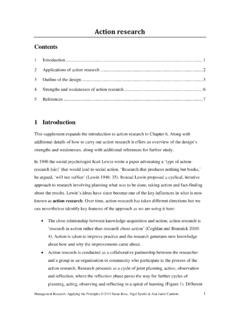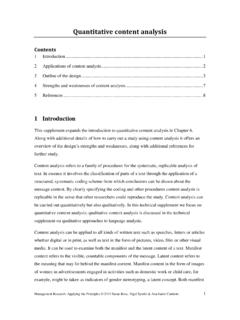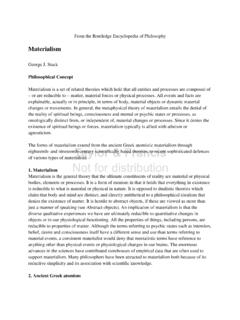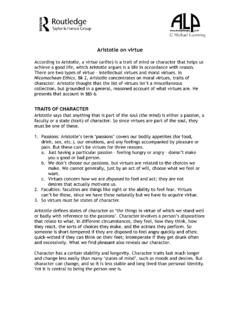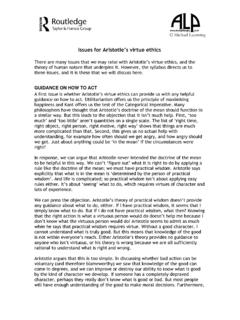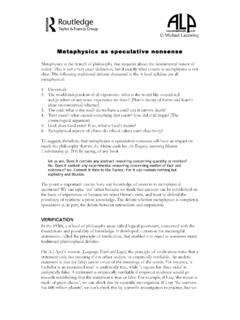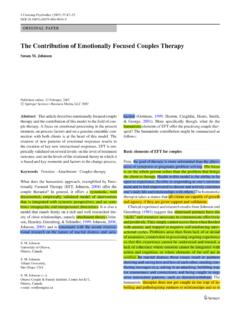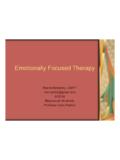Transcription of Therapist Worksheets for In-Session and At-Home …
1 Created by Karen J. Prager, PhD, ABPP 2014 Taylor & Francis Appendix F Therapist Worksheets for In-Session and At-Home Experiments Created by Karen J. Prager, PhD, ABPP 2014 Taylor & Francis IDENTIFY BEHAVIOR-OUTCOME CONNECTIONS IDENTIFY THE PATTERN OF INEFFECTIVE BEHAVIOR. MY CURRENT BEHAVIOR (BEFORE THIS EXERCISE) MY PARTNER S RESPONSE Alternative behaviors (that might elicit a more desirable response): _____ _____ (IF APPLICABLE, AFTER ROLE-PLAY PRACTICE, CIRCLE ALTERNATIVE BEHAVIORS THAT WORKED.) This week I will practice the following: _____ _____ BRING THIS worksheet BACK NEXT SESSION WITH A FOLLOW-UP: How did it work during the week? _____ _____ Created by Karen J. Prager, PhD, ABPP 2014 Taylor & Francis COLLABORATIVE GOAL SETTING Couple Goals Individual Partner Goals for (name)_____ Individual Partner Goals for (name)_____ Created by Karen J. Prager, PhD, ABPP 2014 Taylor & Francis COLLABORATIVE PROBLEM-SOLVING worksheet Couple Contract for what purpose?
2 _____ Step 1: Identify and clarify what the problem is. Partner _____ _____ Partner _____ _____ Changes we hope to see or goals we hope to accomplish through our agreement: Partner _____ _____ Partner _____ _____ Created by Karen J. Prager, PhD, ABPP 2014 Taylor & Francis What each partner will do: When/under what circumstances: How often? For how long? When to evaluate this agreement: Name _____ Name _____ Notes: Created by Karen J. Prager, PhD, ABPP 2014 Taylor & Francis INTIMACY-ORIENTED COMMUNICATION TRAINING FOR COUPLES: Therapist S worksheet Steps in Communication Training Tried it Worked Which partner? Therapist acknowledged _____ s feelings, offers understanding Therapist offers alternative perspective for _____ s communication Intervene with _____ s interpretations o Intervention used: Collaborate with partners to establish realistic communication goals o What was addressed/offered?
3 Behavioral guidance offered o Suggestions offered: Behavioral rehearsal Therapist modeled skill which? Created by Karen J. Prager, PhD, ABPP 2014 Taylor & Francis REVERSE ROLES ROLE-PLAY: In-Session Therapist worksheet Therapist Steps in Reverse Role-Play Tried it Worked Provide a rationale Collaborate with the couple to set up a scenario Sit quietly while couple engages in the role-play Check in and find out how each partner feels about his or her part in the role-play Continue with the role-play, incorporating feedback from the discussion Reverse back to normal roles and replay, incorporating insights gained from the reverse roles role-play Guide post role-play discussion Give homework (that incorporates what the partners have learned from the reverse roles role-play) Additional steps used: Created by Karen J. Prager, PhD, ABPP 2014 Taylor & Francis GIVING DAYS worksheet Partner: Date: What I d like to give to my partner: Feedback: Impact of this gift on my partner.
4 ++ Very positive + Positive 0 Neutral, no impact Today Next Session Circle any gifts that you will give your partner this week: Created by Karen J. Prager, PhD, ABPP 2014 Taylor & Francis Created by Karen J. Prager, PhD, ABPP 2014 Taylor & Francis worksheet FOR EFFECTIVE SELF-EXPRESSION Self-Expression Skills to Work on Open communication about what is going on with me Communicating that I accept my partner as he or she is (or even love him or her as he or she is) and his or her message to me Offering affirmations, compliments Offering reassurances to my partner Bringing up concerns in a way that leads to constructive communication and problem solving Expressing needs, wants without criticizing Demonstrate my respect for my partner (does my partner complain that I don t show him or her respect?) Ask for or stand up for my own needs, wants, and values; be assertive Created by Karen J.
5 Prager, PhD, ABPP 2014 Taylor & Francis EFFECTIVE SELF-EXPRESSION: Therapist worksheet Client s Name:_____ Targeted Communication Goal: Intervention Steps Accomplished: Tried it Worked Model skill Explain skill Role-play practice Feedback session Repeat Targeted Communication Goal: Intervention Steps Accomplished: Tried it Worked Model skill Explain skill Role-play practice Feedback session Repeat Created by Karen J. Prager, PhD, ABPP 2014 Taylor & Francis worksheet FOR IMPROVING LISTENING SKILLS Listening Skill(s) for Me to Work on: Listen quietly without interrupting Be attentive, show interest Listen actively to show I understand my partner s communication: Ask open-ended questions, paraphrase, reflect feelings Monitor my interpretations of my partner s words o Does my partner occasionally or frequently tell me that I am misunderstanding his or her meaning or intentions? o Are there any interpretations I make of my partner s words that seem to cause me trouble (or trouble us as a couple)?
6 Please list some here. Keep myself calm about what my partner is saying to me o What works so far to help me stay calm? Additional goals Created by Karen J. Prager, PhD, ABPP 2014 Taylor & Francis LISTENING SKILL TRAINING: Therapist worksheet Listening Skill Focus for Intervention: Intervention Steps Accomplished: Tried it Worked Model skill Explain skill Role-play practice Feedback session Repeat Listening Skill Focus for Intervention: Intervention Steps Accomplished: Tried it Worked Model skill Explain skill Role-play practice Feedback session Repeat Created by Karen J. Prager, PhD, ABPP 2014 Taylor & Francis EMOTION REGULATION TRAINING: Therapist S worksheet Intervention Step Tried it Worked Empower the client when introducing the training How shall it be or how was it framed? Identify the most troubling emotion Identify and validate healthy goals associated with the current functioning ( , normalize them as part of intimacy regulation) Identify alternative, more adaptive strategies for emotion management (brainstorming process) Test the alternatives as homework; client tries out one or more strategies Which?
7 Created by Karen J. Prager, PhD, ABPP 2014 Taylor & Francis DUAL MONITORING FORM Internal State Emotion 1 10: Observations of My Partner What I See, What I Hear? Interpretation of My Partner s Behavior (Automatic Thoughts): My Immediate Goal/My Long-Term Goal: Is My Interpretation Helping Me to Achieve My Goal? Alternative Interpretation? Internal State Emotion 1 10: Partner s Feedback and Subsequent Interpretation: Created by Karen J. Prager, PhD, ABPP 2014 Taylor & Francis SELF-SOOTHING TRAINING: Therapist S worksheet Intervention Step Tried it Worked Therapist SOOTHES Therapist soothes _____ as he or she becomes more anxious or angry (circle one), or as he or she tries some new behavior (circle one) Therapist soothes _____ as he or she becomes more anxious or angry (circle one), or as he or she tries some new behavior (circle one) SELF-SOOTHING TECHNIQUES Progressive relaxation Three-part breathing Ujjayi breathing Self-soothing with the five senses best senses to work with (circle as many as were tried) o Vision o Hearing o Smelling o Touching o Tasting Soothing self-talk list self-statements tried Created by Karen J.
8 Prager, PhD, ABPP 2014 Taylor & Francis TRAINING TO INCREASE EMOTION TOLERANCE: Therapist S worksheet Intervention Step Tried it Worked Stop defensive behavior and encourage inward emotion focus Encourage client to label and stay focused on the emotion Encourage the client to accept the emotion and to accept him- or herself with the emotion Notes: Created by Karen J. Prager, PhD, ABPP 2014 Taylor & Francis SELF-EMPOWERMENT TRAINING: Therapist S worksheet Intervention Step Tried it Worked Therapist Persuasions: Letting go of blame in favor of self-empowerment o You ll feel less upset. o You ll feel competent in your relationship with your partner just as your other roles and relationships are competent. o You can feel yourself to be a fellow traveler in life with your partner instead of feeling one down. o You can work on yourself and avoid the frustration of attempting the impossible changing your partner.
9 O You ll gain benefits even if you two don t stay together. o Other persuasion Self-Empowering Interventions: o Teach pause before speaking o Model empowered responses o Teach cognitive self-soothing soothing self-talk o Affirm empowered self-schema o Help client create cognitive dissonance about old, disempowered self-schema o Use the so-what technique with an I am too fragile schema o Work with client to change negative self-schema o Work with client to change unrealistic partner schemas ( , My partner has all the power) o Acceptance training: Encourage self and partner acceptance o Teach self-expression and listening skills Created by Karen J. Prager, PhD, ABPP 2014 Taylor & Francis SELF-EXPRESSION worksheet FOR BUILDING NEW RELATIONSHIPS Self-disclosure and active listening are great skills to learn for meeting and getting to know new people. People who hesitate to share themselves often say that they were not raised that way, meaning that they rarely heard people in their families talk about personal, private things that they had on their mind to an empathic, caring listener.
10 As a result, you may feel clumsy or awkward or nervous when it comes to opening up about yourself, expressing warm feelings, or giving others the gift of attentive listening. Fill out this Checklist of Intimacy Concerns. It will get the ball rolling on helping you to make more rewarding connections with other people. Score yourself on the reverse of this form. Check each of the statements below that applies to you. ___1. I sometimes fear that the other person will discover things about me that are undesirable, bad, or shameful. ___2. I sometimes fear that the other person will abandon me if he or she knows my deepest thoughts, either by leaving me, withdrawing his or her affection, or betraying me. ___3. I sometimes fear that the other person will use personal things he or she knows about me against me, to hurt me. ___4. I sometimes fear that the other person will tell my secrets to others. ___5. I am sometimes bothered by feeling more emotional with the other person than with other people.
